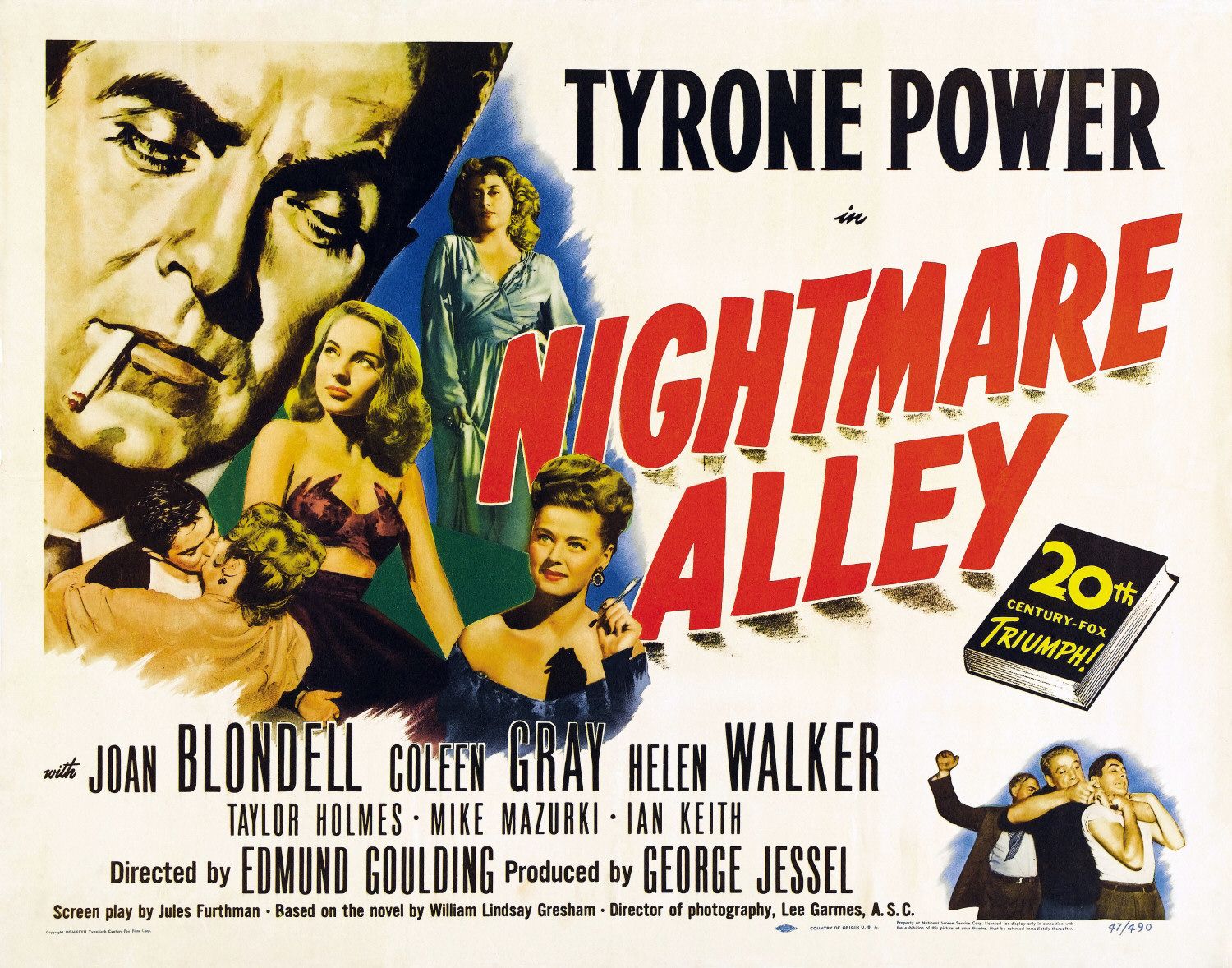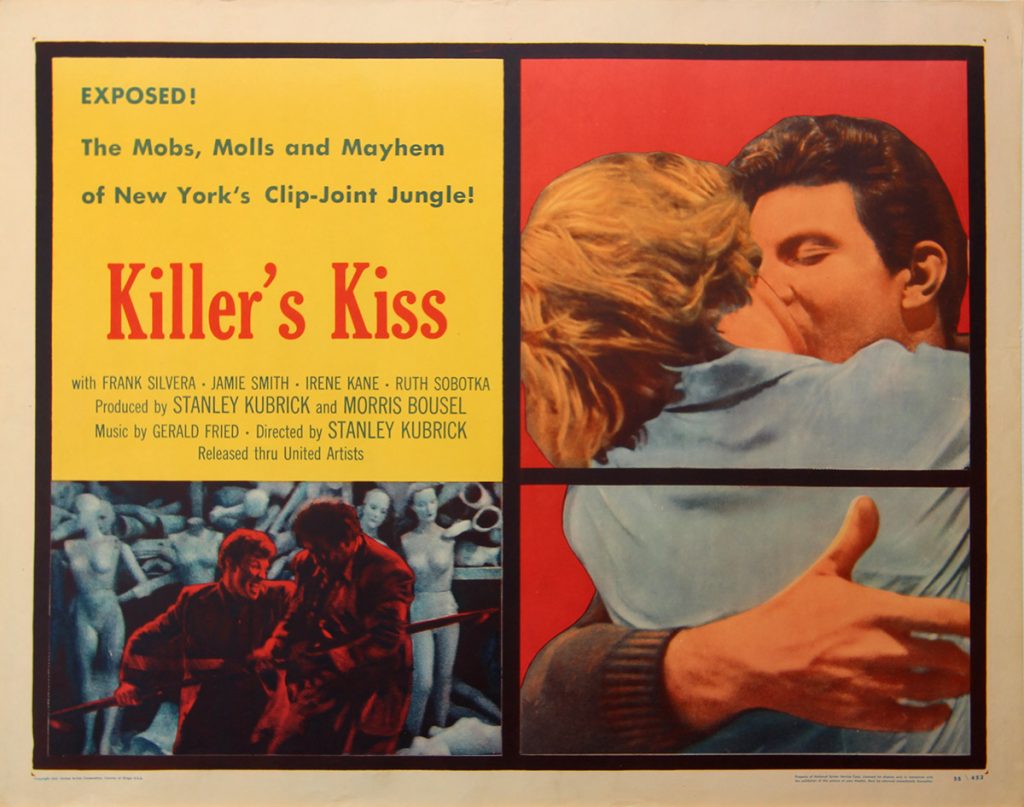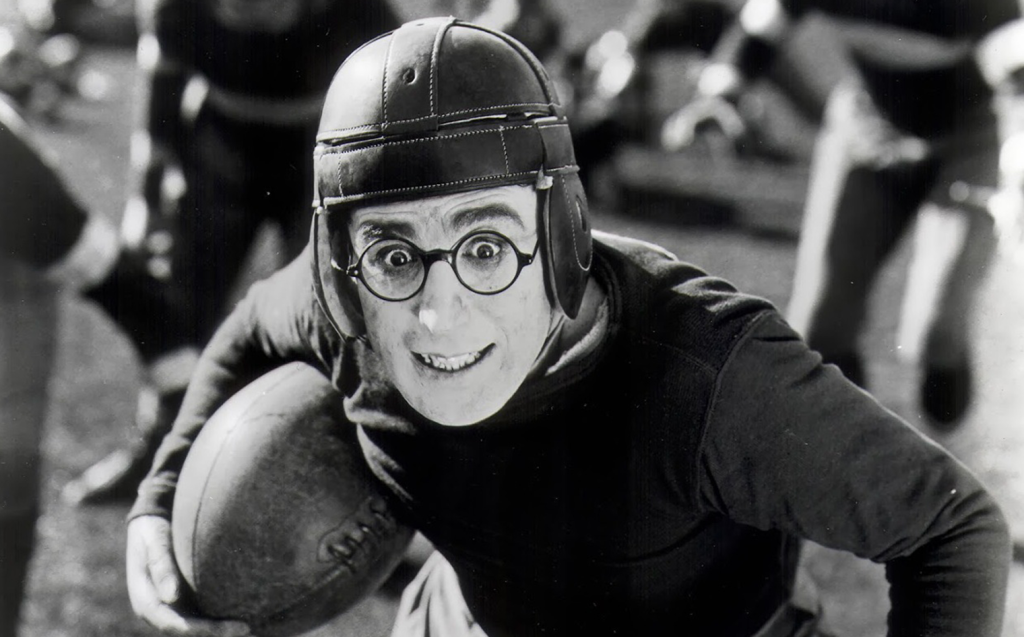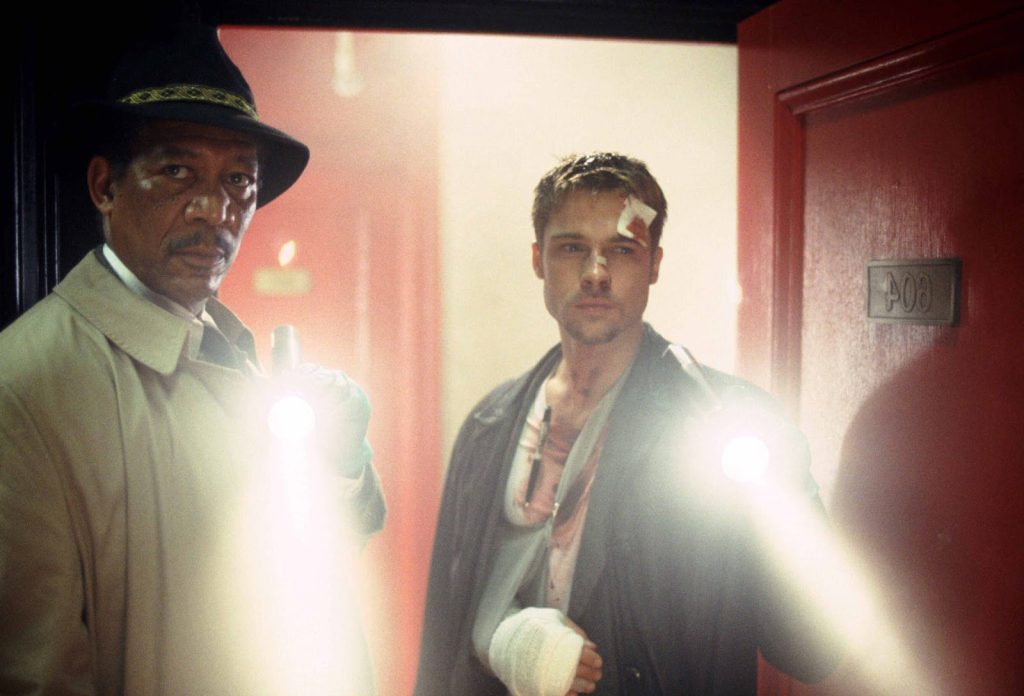Guillermo Del Toro is raising Nightmare Alley from the dead, resurrecting the 1946 William Lindsay Gresham novel upon which the 1947 noir of the same name was based—now streaming in the Criterion Channel’s Fox Noir series. Though a box office failure, with a reputation as cursed, a look back at the earlier film nonetheless makes it easy to understand Del Toro’s temptation to conjure these particular ghosts: especially anti-hero Stanton Carlisle, a phony “spiritualist” who rises from the mists of a (bygone era’s) traveling carnival, and frigid femme fatale Dr. Lilith Ritter, a scheming psychologist who out-swindles the swindler.
The novel’s backstory itself is gloomy, intersecting as it does with the midcentury disillusionment of the American Left. In the midst of the Depression, Gresham worked as a folk singer in Greenwich Village, joined the Communist Party and enlisted in the Abraham Lincoln Brigade in the Spanish Civil War against Franco, a “premature” anti-fascist, as he would be tarred by postwar Red-baiters. In Spain, one of Gresham’s fellow soldiers was an ex-carny who regaled him with sordid tales of carnival life, revealing the secrets behind various ‘magic’ tricks and the sideshow attractions known as “geeks”—carnies intentionally “made” into desperate alcoholics and, in turn, into raving ‘freaks’ suffering delirium tremens, willing to bite off the heads of live chickens, for payment in booze.
When Gresham returned stateside, he himself devolved into alcoholism and a suicide attempt (his second was successful in 1962) before finding (temporary) solace in psychoanalysis and in crafting all that carny material—and his cynicism about the American Way—into Nightmare Alley, in which sleights-of-hand-as-popular-entertainment escalate into ever more lucrative levels of deception and human degradation, climbing out of rural carnival grounds into the Big City and Big Money. Apparently, Gresham’s dark outlook touched a nerve, joining 1946’s bestseller lists alongside Frederick Wakeman’s The Hucksters and Robert Penn Warren’s All the King’s Men, themselves darkly cynical about fraud (and the public’s gullibility) in American advertising and politics, respectively.
Unafraid of a little controversy or sordidness (in fact, attuned to their box office potential), 20th Century Fox’s head Darryl F. Zanuck snatched up the film rights to Gresham’s novel, assigned veteran scenarist Jules Furthman and veteran director Edmund Goulding to the project, and conceded to Tyrone Power’s insistence on being cast, against his romantic hero type. For Power, the role of Stan represented a chance to prove he was more than just a pretty-faced matinee idol. For the part, Power is made ugly—a line that might also describe one of classic noir’s defining characteristics.
Tyrone Power makes the most of the opportunity. His Stan, around whose charisma the film revolves, is complex: a good-natured and sensitive empath (which serves him well as a pretend psychic) marred by a fatal flaw—self-centered ambition—about which he marvels, as if an outside observer. “I wonder why I’m like that,” he muses. Early on, as a new carnival barker, he describes the perverse pleasure he derives from duping the people, which allows him to feel “superior” to the “yokels.” “I was made for it,” he enthuses. (Keep your ears open for this line’s echo towards the end). Inexorably driven, Stan will scrape his way to fame and fortune, becoming “Stanton the Great,” a “mentalist” who performs before the doyens of Chicago’s high society. But this is noir, and so we know this will not be a great American success story, not a tale of progress but devolution. The dead end is predetermined in the (otherwise nonsensical) title and in the Tarot readings that literalize noir’s fatalism. Stan is foredoomed for the geek pit, destined to fall for reaching too high, as the film’s last line of dialogue moralizes.
Here’s how it happens: we first meet Stan watching the geek sideshow. (The film viewer, however, will be denied a good look at The Geek, given the debacle of MGM’s Freaks (1932) and subsequent prohibitions against “gruesomeness” written into the Production Code, about which much ink has been spilled.) “That guy fascinates me,” Stan explains to the carnival boss, asking, “How do you get a guy to be a geek?[…] [I]s a guy born that way?”

But there’s no time to dwell on this loaded question. Stan must rouse the passed-out drunk Pete (Ian Keith) for their act with Pete’s wife Zeena (a mature Joan Blondell), a “seeress” who pretends to read minds, with Pete and Stan’s help and a nifty little stage trick. That’s nothing, carny-babe Molly (a dewy-faced and scantily-clad Colleen Gray) explains to Stan. Pete and Zeena once had an even better act, using a “two-person code” (“worth its weight in gold”)—a system for communicating audience members’ written questions through word choice and intonation. But that was before Pete became a “rum dumb,” halfway to geekdom, a cautionary tale that Stan ignores at his peril.
To get ‘The Code,’ Stan seduces Zeena and accidentally kills Pete, taking pity on his DTs and pleas, unknowingly handing him a bottle of Zeena’s prop alcohol—a mistake that haunts Stan with guilt even as he sets out to profit from it. Replacing Pete as Zeena’s partner, Stan masters The Code, wowing carnival crowds and Molly, who he charms into premarital sex, not so subtly implied. Zeena certainly catches on, forcing Stan to legitimize the consummation with marriage, albeit after the fact. Ever scrappy, Stan plays the forced union to his advantage, grooming his young bride as his new stage partner. Trading his striped blazer for a tux and her sequins leotard for a ballgown, they bring their act to Chicago’s swankiest nightclub, complementing The Code with Stan’s uncanny ability for “stock readings,” a trick that that undercuts (American) Individualism, which only blinds people to their own (predictable) commonality.
One fateful night, Stan and Molly’s audience contains Dr. Lilith Ritter (Helen Walker), a brilliant and beautiful psychologist who easily deciphers The Code for two older gentlemen at her table. This is our first clue that Dr. Ritter is Nightmare Alley’s femme fatale, notwithstanding the film poster’s triangulation of that role. Tellingly, Stan is blindfolded as their power play begins that night. He is a “seer” who doesn’t see, a mind-reader who misreads a superior mind-reader–in a notable conflation of phony mentalism with professional psychotherapy, then gaining traction in postwar America. Also conflated is female professionalism with emasculation. When Stan visits Dr. Ritter’s office, and then her apartment, he finds her in power suits and himself in striated shadows, noir’s preferred signifiers of the spider woman. She out-talks him and commands the frame. (For viewers who wonder why the scene-stealing Walker wasn’t a bigger star, the answer lies in a tragic car accident—with Walker at the wheel—involving booze and hitchhiking war veterans; one died and the others sued, successful in the court of public opinion if not the court of law. Unfolding during Nightmare Alley’s anemic first run, Walker’s tragic fate is one of the reasons the film was considered cursed.)
It is Dr. Ritter who suggests the darker scheme that will ruin Stan: using the personal details gathered (and recorded) in her clients’ sessions to fleece them in the nightclub, convincing them of Stan’s powers, now enlarged to include communion with their dearly departed. Dr. Ritter draws our Icarus nearer the sun, until a final séance goes disastrously wrong. The jig is up but Stan alone will take the fall, because Dr. Ritter has outwitted him. The scene of her icily clinical diagnosis of his delusional order is worth the price of admission alone.
All that’s left then is the rapid downward spiral into alcoholism and the geek pit. Stan returns to the carnival, desperate for a job and stinking of beer, both of which the carnival boss sniffs. In the film’s final moments, renowned cinematographer Lee Garmes enjoys one last chance to show off in the carnival grounds, with marvelous crane shots and roaming spotlights. Stan-as-geek veers madly at midnight past cages, carousels, and ferris wheels, running into Molly’s arms (in a lame Zanuck insert meant to soften noir’s and the source novel’s sting) and, ultimately, into the more believably bleak moral about hubris, aforementioned.
On December 17, when Del Toro releases his version of Gresham’s novel in theaters, will he pull off this cinematic séance? Will his gifted showman’s ambition pay off or go down in flames? I, for one, can’t wait to see.
“Nightmare Alley” is now streaming on the Criterion Channel.



